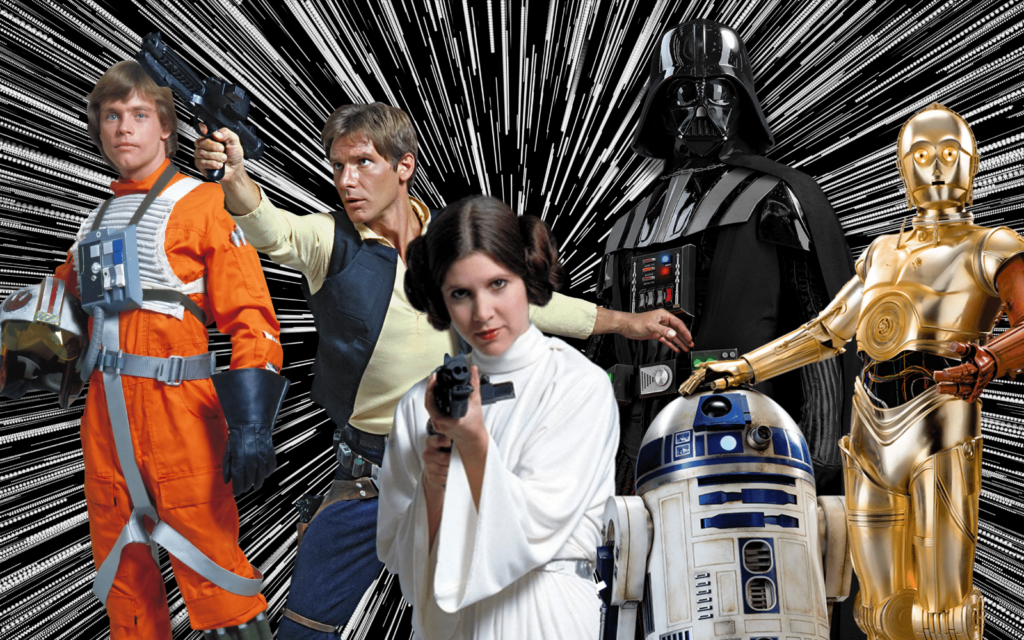“These aren’t the droids you are looking for,” Obi-Wan Kenobi famously said at the beginning of the first Star Wars movie 46 years ago. But it turns out these were precisely the droids, adventure and excitement that the world was waiting for.
When it was first screened in 1977, Star Wars was a groundbreaking new form of cinema, using a risky context (set in space) but filled with captivating characters and grand themes that would make it an instant success.
Star Wars was not just an epic movie itself – and part of an equally legendary trilogy — but broke new ground in filmmaking techniques, pioneering special effects that would make its post-production house Industrial Light & Magic one of the greatest FX studios around. The fact that the special effects are still compelling four decades later is a testament to how innovative and realistic they were.
Star Wars is a space opera, a grand tale filled with the ingredients of a Wagnerian showpiece. Told in a breathtakingly original way, it minted the gold standard for both science fiction films and Hollywood blockbusters. “A young, enthusiastic crew employs far-out technology to put a rollicking intergalactic fantasy onto the screen,” American Cinematographer magazine gushed in July 1977.
Part of this originality included its realism. Previous sci-fi film adaptations, like Flash Gordon and Buck Rogers, had unrealistic, glossy and cheesy space settings. Director George Lucas asked his designers to make everything look gritty and aged — what he called a “used future”.
It was a labour of love for Lucas, who battled the indifference of numerous studios that did not want to produce his masterpiece. When 20th Century-Fox eventually agreed to back it, Lucas made an innovative business decision, retaining the rights for the sequels and merchandise, which have earned $42 billion (R766 billion) in revenue. This is more than Harry Potter and James Bond combined in 2017, according to Fortune.
Groundbreaking
Watching the original Star Wars movie — as a six-year-old when it was first screened in cinemas — I knew that anything was possible.
At its core, it is a simple tale of good versus evil, but it also references other storytelling techniques and myths. The good rebels fight the evil empire. Against the odds. Vastly outnumbered. In their darkest hour. But good ultimately triumphs.
In Luke Skywalker, whose innocence growing up on a backwater planet creates a moral universe for the epic tale to unfold against, we have an everyman hero that most young men could identify with. Stuck doing chores, he is propelled into a world of adventure, glamour, danger and excitement, lightsabers and space fighters.
He discovers — as every young boy wished they could — that he is part of a secret global organisation fighting to make the galaxy a better place, and could possibly become a Jedi Knight.
Read More: Looking for discounted Star Wars games? Some of last year’s specials have returned in 2023
The Jedi Knight is something of a cross between the connectedness of Buddhism and the Bushido warrior code of the Samurai. Jedis can harness the power of the mystical Force, which gives them the ability to levitate themselves or other objects (as Yoda demonstrated to Luke in The Empire Strikes Back) and choke people (as Darth Vader did in just about every film). With the Force, they can use mind control, as Obi-Wan did with the droids, or sense other Jedi — including the evil Sith — who “turn to the Dark Side,” a phrase that is arguably one of Star Wars’ most successful incorporations into popular culture.
Grand adventure
The first film’s title was later changed to Star Wars IV: A New Hope, signifying that this grand saga had actually started somewhere in the middle. It was part of a greater mythology that Lucas would expand upon in subsequent episodes.
With its equally iconic sequels, The Empire Strikes Back (1980) and Return of the Jedi (1983), Star Wars made household names of its characters and stars — Luke Skywalker (played by Mark Hamill), the swashbuckling Han Solo (Harrison Ford), the enigmatic Princess Leia (Carrie Fisher), the mystical hermit warrior Obi-Wan Kenobi (Alec Guinness) and the ever-threatening Darth Vader (voiced so memorably by James Earl Jones).
The droids in question, R2-D2 and C-3PO, would become as legendary as the human characters; as would Solo’s sidekick, the hairy Chewbacca.
Star Wars’ most-loved character is arguably the diminutive hermit sage Yoda, whose back-to-front syntax produced maxims still mouthed by geeks and tech start-ups: “Do. Or do not. There is no try.”
Few fictional characters have had as much of an impact and as endearing a legacy of being endlessly quoted, as Yoda, whose puppet’s face was partly modelled on Albert Einstein.
A Star Wars toy story
Good triumphs, as do endless returns at the box office and toy store. Star Wars figurines still sell strongly but when Lego started making Star Wars kits in 1999, it added another huge revenue stream for these two great brands and introduced another generation to the joys of the Jedi universe.
The world would be a lesser place without the clip of Eddie Izzard’s “Do you know who I am?” parody of Darth Vader getting lunch on the Death Star dubbed over Lego figurines.
It all began, with those bold yellow words disappearing into the distance:: “A long time ago in a galaxy far, far away…”
- This article originally appeared in the Sunday Times.
